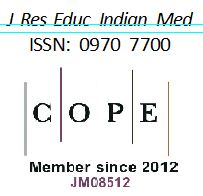
1. JREIM Covering Letter and Authors Declaration Form (Section 1-5) Ver. Jan 2021
2. TITLE page - Abstract - References etc-Sections -1 to 6 (NEW 2020-21)
3.JREIM Proforma for Authors CV and Declaration cum Consent Form-Ver-R -151022
4. JREIM Template for Submitting Manuscript in JREIM
| Original Research Online Published: 14 Jun 2015 | ||||||||||||
J Res Educ Indian Med . 2007; 13(1): 7-16 DNA FINGERPRINTING : A NEW PHARMACOGNOSTIC TOOL FOR STANDARDIZATION OF HERBALS SHRIVASTAVA S, DUBEY D, SHWETA K, SANJAY J, DUBEY P.K.
| ||||||||||||
| How to Cite this Article |
| Pubmed Style SHRIVASTAVA S, DUBEY D, SHWETA K, SANJAY J, DUBEY P.K. DNA FINGERPRINTING : A NEW PHARMACOGNOSTIC TOOL FOR STANDARDIZATION OF HERBALS. J Res Educ Indian Med . 2007; 13(1): 7-16. Web Style SHRIVASTAVA S, DUBEY D, SHWETA K, SANJAY J, DUBEY P.K. DNA FINGERPRINTING : A NEW PHARMACOGNOSTIC TOOL FOR STANDARDIZATION OF HERBALS. https://www.jreim-ayushjournal.com/?mno=191535 [Access: September 15, 2024]. AMA (American Medical Association) Style SHRIVASTAVA S, DUBEY D, SHWETA K, SANJAY J, DUBEY P.K. DNA FINGERPRINTING : A NEW PHARMACOGNOSTIC TOOL FOR STANDARDIZATION OF HERBALS. J Res Educ Indian Med . 2007; 13(1): 7-16. Vancouver/ICMJE Style SHRIVASTAVA S, DUBEY D, SHWETA K, SANJAY J, DUBEY P.K. DNA FINGERPRINTING : A NEW PHARMACOGNOSTIC TOOL FOR STANDARDIZATION OF HERBALS. J Res Educ Indian Med . (2007), [cited September 15, 2024]; 13(1): 7-16. Harvard Style SHRIVASTAVA S, DUBEY D, SHWETA K, SANJAY J, DUBEY P.K (2007) DNA FINGERPRINTING : A NEW PHARMACOGNOSTIC TOOL FOR STANDARDIZATION OF HERBALS. J Res Educ Indian Med , 13 (1), 7-16. Turabian Style SHRIVASTAVA S, DUBEY D, SHWETA K, SANJAY J, DUBEY P.K. 2007. DNA FINGERPRINTING : A NEW PHARMACOGNOSTIC TOOL FOR STANDARDIZATION OF HERBALS. Journal of Research and Education in Indian Medicine, 13 (1), 7-16. Chicago Style SHRIVASTAVA S, DUBEY D, SHWETA K, SANJAY J, DUBEY P.K. "DNA FINGERPRINTING : A NEW PHARMACOGNOSTIC TOOL FOR STANDARDIZATION OF HERBALS." Journal of Research and Education in Indian Medicine 13 (2007), 7-16. MLA (The Modern Language Association) Style SHRIVASTAVA S, DUBEY D, SHWETA K, SANJAY J, DUBEY P.K. "DNA FINGERPRINTING : A NEW PHARMACOGNOSTIC TOOL FOR STANDARDIZATION OF HERBALS." Journal of Research and Education in Indian Medicine 13.1 (2007), 7-16. Print. APA (American Psychological Association) Style SHRIVASTAVA S, DUBEY D, SHWETA K, SANJAY J, DUBEY P.K (2007) DNA FINGERPRINTING : A NEW PHARMACOGNOSTIC TOOL FOR STANDARDIZATION OF HERBALS. Journal of Research and Education in Indian Medicine, 13 (1), 7-16. |









